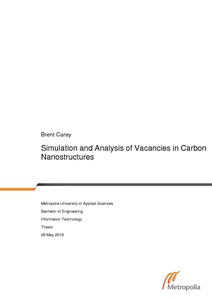Simulation and Analysis of Vacancies in Carbon Nanostructures
Carey, Brent (2018)
Carey, Brent
Metropolia Ammattikorkeakoulu
2018
All rights reserved
Julkaisun pysyvä osoite on
https://urn.fi/URN:NBN:fi:amk-2018060312154
https://urn.fi/URN:NBN:fi:amk-2018060312154
Tiivistelmä
The discovery of the Buckminsterfullerenes in 1985 marked the beginning of the research field in carbon nanostructures. Since then, several more carbon allotropes existing in the nanoscale have been discovered, most notably the carbon nanotube and graphene. Due to the small scale of these materials, research is difficult, and production requires state of the art equipment to create even small samples. However, study has only increased with the accumulation of desirable properties these materials hold, boasting thermal and electrical conductivity, as well as immense strength. As the properties of carbon nanostructures continue to emerge, numerous research groups in academia have begun studying the synthesis and applications of these versatile materials.
This thesis aims to provide a supplementary insight to how the behavior of a vacancy in carbon nanostructures changes when energy is added to the system. While research of this kind is often done in a laboratory, this analysis is conducted in a digital environment, examining the relevance of simulations in comparison to ideal results.
The two primary software packages used for the simulations are Atomic Simulation Environment (ASE) and Large-scale Atomic/Molecular Massively Parallel Simulator (LAMMPS). ASE provides tools to build, visualize, and export atomistic structures. These tools were used to generate and prepare the carbon nanotube and graphene nanoribbon for the forth-coming simulations. LAMMPS imports the exported ASE structures and executes the molecular dynamics simulations using the Tersoff potential for interatomic interactions.
Digital experiments regarding phenomena in natural science is enhancing how modern re-search is conducted. They provide both valuable insights to experiments and can model hypothetical scenarios that are difficult to physically execute. Simulations do have limitations such as system size and complexity of the model. The molecular dynamics simulations con-ducted in this project can be ran on a personal computer; however, some systems require considerable computation, needing the computing power a supercomputer. While there will always be need for the laboratory, simulations can be an economical and effective means for augmenting research.
This thesis aims to provide a supplementary insight to how the behavior of a vacancy in carbon nanostructures changes when energy is added to the system. While research of this kind is often done in a laboratory, this analysis is conducted in a digital environment, examining the relevance of simulations in comparison to ideal results.
The two primary software packages used for the simulations are Atomic Simulation Environment (ASE) and Large-scale Atomic/Molecular Massively Parallel Simulator (LAMMPS). ASE provides tools to build, visualize, and export atomistic structures. These tools were used to generate and prepare the carbon nanotube and graphene nanoribbon for the forth-coming simulations. LAMMPS imports the exported ASE structures and executes the molecular dynamics simulations using the Tersoff potential for interatomic interactions.
Digital experiments regarding phenomena in natural science is enhancing how modern re-search is conducted. They provide both valuable insights to experiments and can model hypothetical scenarios that are difficult to physically execute. Simulations do have limitations such as system size and complexity of the model. The molecular dynamics simulations con-ducted in this project can be ran on a personal computer; however, some systems require considerable computation, needing the computing power a supercomputer. While there will always be need for the laboratory, simulations can be an economical and effective means for augmenting research.
